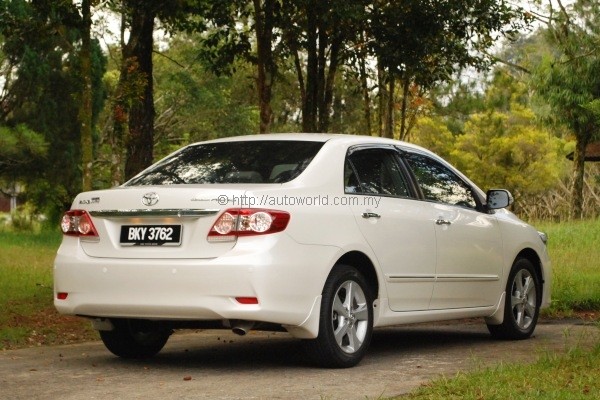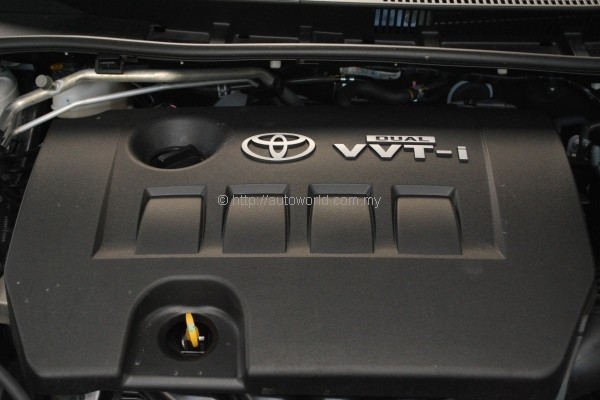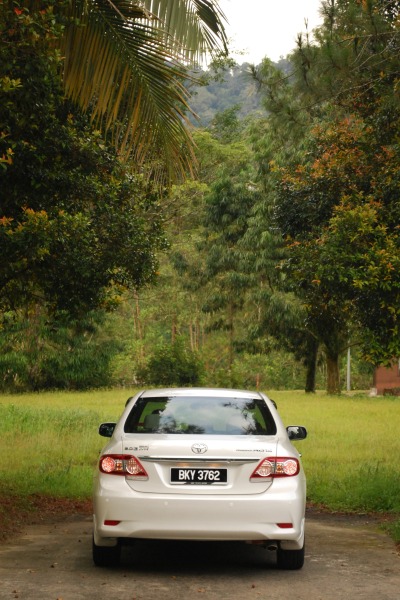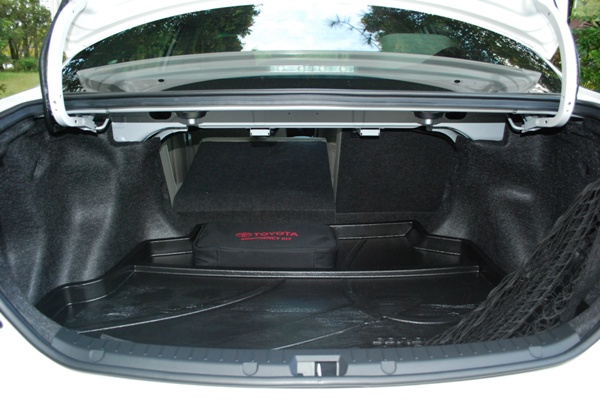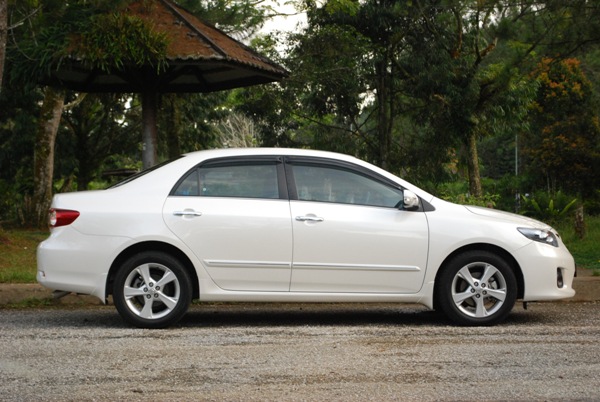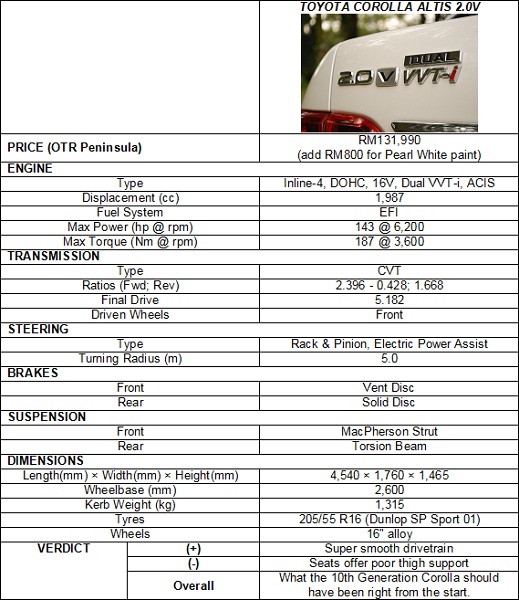Corolla Altis 2.0V – Toyota wakes up
There was a time when the Toyota Corolla and Honda Civic competed neck-on-neck. Both models were good cars on their own merits and the choice of one over the other was usually down to taste rather than outright superiority of either model. Then, something happened – Toyota went to sleep and gave us a half-baked effort when a supposedly all-new Corolla Altis was launched in March 2008.
At that time, the all-conquering eighth generation Honda Civic was already two years in the market, and Toyota supporters were eagerly awaiting the response from their camp. An ‘all-new’ model that seemed more like a facelift and had carry-over engineering from the predecessor was not what they had in mind.
Since then, not only did the Corolla have to watch the Civic pull clear at the top of the sales charts, it also had to watch over its shoulder for a charge of pretenders lead by the Nissan Sylphy and Mitsubishi Lancer eagerly making ground on it. It was not a situation that Toyota was pleased to find itself in for sure, and drastic measures were put in place to haul the Corolla back into its place at the market’s forefront. The product of these efforts is the newly launched Corolla Altis facelift introduced a couple of months ago.
Prices & Variants
The new Corolla enters the market with a four-variant line-up, which starts with the entry-level 1.6E going for RM105,990 with insurance in Peninsula Malaysia, up from RM102,900 for the previous model. Moving up, we have the 1.8E going for RM112,990 on the same pricing terms.
On paper, the sensible pick of the range would appear to be the 1.8G which goes for RM122,990. Save for cruise control, a bigger engine, and some styling differences, this higher spec 1.8-litre model loses little to the top-of-the-range 2.0V, priced at RM131,990.
The Test Car
Our test car for this review is the top spec 2.0V model finished in White Pearl paint, which adds RM800 to the final purchase price. Fit and finish was generally good, but the front bumper seemed to have an unfortunate habit of going out of alignment at the seams. UMWT personnel assured us that the car was accident free, so we can only assume that it was a fitment error.
Overview of the Facelift efforts
No changes are made to the sheet metal or platform, and external revisions are limited to the usual bumper, rim and lamp upgrades. Updates are similarly minor in the cabin as well. The overall architecture of the dashboard remains, with changes made only to offer newer and better looking grades of wooden trim. Seat materials are altered too, with newer grades of fabric or leather supplied where applicable.
However, once you look beyond the marginal but effective cosmetic upgrades that was made to the Corolla, you immediately have an idea how hard Toyota must have been hit in the highly competitive C-segment. It is not usual for a Japanese make to include powertrain revisions in its facelift exercises, but this is exactly what Toyota has done. Not only was a 2.0-litre variant added to the mix, the 1.6 and 1.8-litre models have similarly benefited from new engines, with the new ZR series powerplants taking the torch from the outgoing ZZ series.
The new ZR engines feature Dual VVT-i across the board. Additionally, the 1.8 (2ZR-FE) and 2.0-litre (3ZR-FE) gets Toyota’s version of a variable air intake manifold, officially dubbed the Acoustic Control Induction System. The two bigger-engined models also get Toyota’s Super CVT-i transmission in place of the 4-speed auto which the 1.6 continues to make do with.
Driving Experience
The 3ZR-FE powering our Corolla 2.0V test car makes 143hp @ 6,200rpm and 187Nm @ 3,600rpm. That’s not exactly on top of the pile, but it’s about enough to keep fellow 2.0-litre rivals in check. What it does have in abundance is refinement, which is matched only by the MR20DE engine used by the Nissan Sylphy.
Another trait which the Corolla shares with the Sylphy is a silky smooth continuously variable transmission (CVT). Motoring enthusiasts often malign CVTs for a lack of driving excitement. Toyota’s in-house developed contraption goes some way to alleviate that somewhat unfair criticism. In sedate driving, the Super CVT-i behaves with the typical feel of a CVT, but when you give it the full pelt, it shifts between ratios in steps, behaving like a torque converter transmission instead.
Know that the Corolla did not transform to a sports machine over night, but the overall driving experience remains a pleasant one. It does not corner with the fluency of say, a Ford Focus, but the Corolla is also a rewarding drive in its own way. It gathers pace with great smoothness and serenity, making it an excellent highway cruiser.
Nothing puts your brakes to the test like idiot drivers, and I found that out myself when an errant driver suddenly thought it was an excellent idea to cut into my lane as I was overtaking him. Without space on either side, my only option was to slam the brakes. Although the four discs were able to shave impressive amounts of speed from the speedo, the Corolla nosedived quite a bit as we decelerated – showing up the soft nature of its chassis.
When we pushed it hard along twisty B-roads, the Corolla felt competent without being fully confident, despite what appeared to be generous grip offered by its tyres. There is quite a bit of roll and understeer to encourage easing off when cornering enthusiastically. Having said that, we don’t expect the typical Corolla owner to hit the back roads that often, let alone push it to the limits.
In the confines of city and highway driving, however, the Corolla is more than adequate to serve a pleasant and fuss-free driving experience. The peaceful and serene nature of the cabin on the move should also go down well with most passengers on a long haul. Our only real criticism when driving the car is its unusually short front seats, which severely lacked thigh support.
Verdict
Since the first generation KE10 model was launched in 1966, the Corolla has come a long way becoming the best selling nameplate ever in automotive history. The tenth generation Corolla entered the scene on a whimper two years ago but it has now lifted itself back to a level worthy of your consideration.
I won’t call it the best model in the Corolla’s history; that accolade still belongs to the seventh-generation AE101. The AE101 ‘mini-Lexus’ is to the Corolla what the W124 is to the Mercedes-Benz E-Class – built and developed with a money no object approach, and the likes of which we will never see again.
Taking the Mercedes E-Class as a parallel, the latest Corolla Altis can then be likened to what I think of the current W212 model – not the best Corolla ever, but certainly the best that we’ve seen in a long time.
 |





